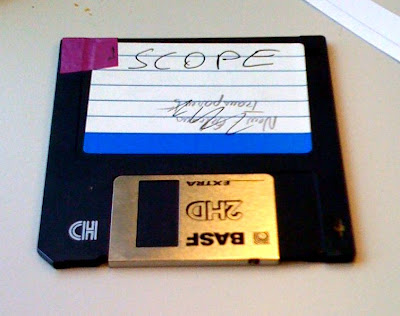Today I saw a funny thing during an experiment on the 'scope. Naturally, I wanted to file a copy of the mesurement for future reference. Previously, this wouldn't have been a problem, because I was using a very modern oscilloscope, which even had a USB interface and a network plug (And - of course - a sticker saying "This is a scientific instrument, do NOT use it to browse the internet). I had to downgrade to an older Waverunner LT 344, because my student wanted to control it via the PC, and programming the GPIB bus is much easier than figuring out this new-fangled TCP/IP thing.
The older oscilloscope is actually much nicer to use - it does not use a stupid touchscreen (which will misread the position of your finger on principle), and it does not run MS Windows. That means that when you switch it on it is on - no waiting for five minutes for the stupid thing to boot. Of course, the trigger is not as sophisticated, it is a bit slower, etc., etc., but I am not using microwaves anyway.
But, the 'scope can only safe it's traces to 3.5'' floppies. So I scrounged one up (this is a lab, we have all kinds of 'obsolete' storage media floating around - 3.5'' floppies, 5 1/2'' floppies, zip disks, minidisks, you name it, we have it. Somewhere.), inserted it - and the scope complained about 'bad format'. Naturally. Next, I tried the following solution:
Veterans of the DOS area will recognise the pink tape as an attempt to make a HD (High Density, 1.44 MB) floppy behave like a DD (Double Density, 720 KB) floppy. Back in the eighties I used to do it the other way 'round: Drill a hole into an old DD floppy and hey presto!, you can store twice as much on it. Doesn't do much for your data retention rate of course, but it will hold up long enough to get a copy of that hot new AMIGA game. Now I tape up the hole to fool my oscilloscope. Which is almost as much fun.
Anyway, next you have to format your disk, and there I ran into the next problem: Windows XP does not do 720K anymore.
"You want me to do what?"
Not a problem, I thought. I'll just head over to the command line, and use the old FORMAT A: /F:720.
Nope.Windows XP does not do 720K anymore.
Thankfully, I have no photographic documentation for what followed, but yes, I did do the "Angry Monkey" dance.
Never one to be put off easily by those infernal, modern devices that govern our daily lives, I searched the internet for an answer, and lo and behold, the oracle answered with the cryptic statement: FORMAT A: /T:80 /N:9. Now which genius in the developement team of Microsoft came up with the glorious idea of taking out the 720K option? I can see the reason for leaving it out of the GUI - you don't want to confuse users needlessly. But the command line? Who thought: "I know, let's take out all the old backwards compatibility for floppy disks, only not completely. This way, we can frustrate savy users, but still have happy floppy-formating fêtes in the evening!"
Anyway, the internet was right as always, so I headed down to the lab with my new DD disk. The oscilloscope took one quick look at it and smugly replied 'bad format'.
One quick "Angry Monkey" dance later, I sighed and went to dig up the documentation (Always the last thing to do for any self-respecting scientist). Turns out that the stupid thing can read HD floppies - only the floppy drive seems to be broken.
So finally I did what I should have done in the first place: I snapped a quick photo of the screen with my iPhone. Yay high-tech!





I got a headache just reading this. I wish this story didn't feel so damn familiar...
ReplyDeleteI think this is a very common tale of woe. And to think - I know about all these obsolete formats because I have used them as a kid. Well, a couple of months back I needed to use an old HP Network analysor, that used a weird disk proprietary HP format that was only 'common' for about a year or so around 1980. How to read that on a Windows PC really threw me - it took more than a day before I stumbled over the answer in some obscure forum.
ReplyDeleteI pity the next generation of scientist though, who will have all our different hardware/software formats to wade through!
It seems that nothing has changes much at CRPP :-) And thanks for the high-tech capture of your data, but what is it anyway?
ReplyDeleteGreets from Kathmandu
The upper trace is light (well, actually just noise, because the discharge was too faint for the PM to pick up), while the lower one is the Voltage of the glow discharge. Anyway, in the end it turned out not to be interesting after all ;)
ReplyDelete